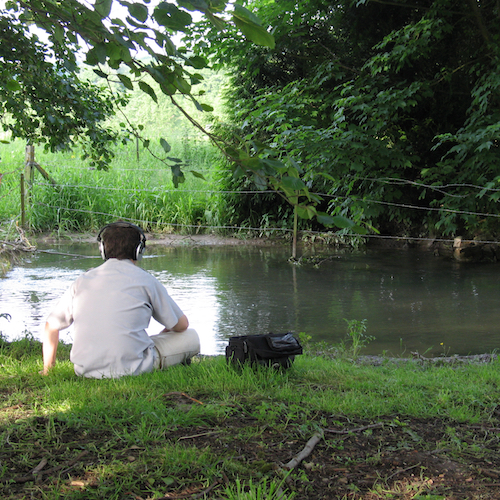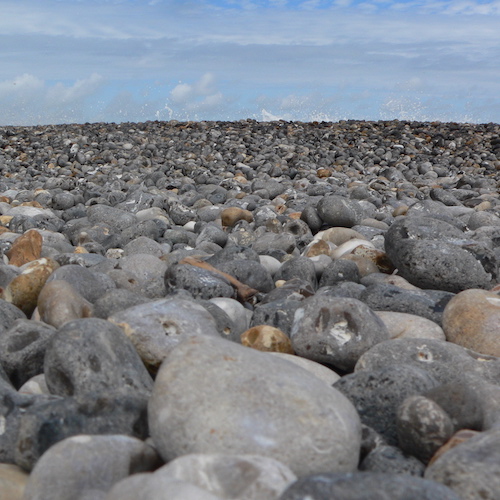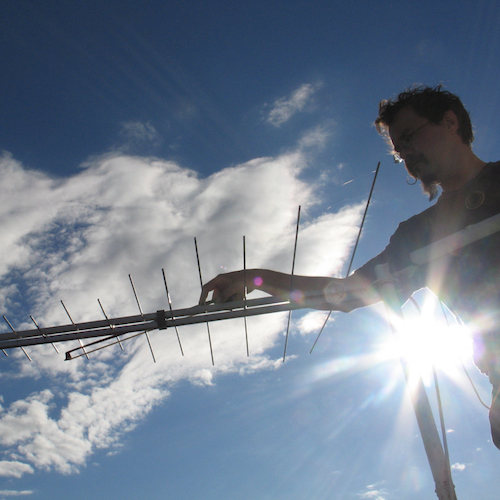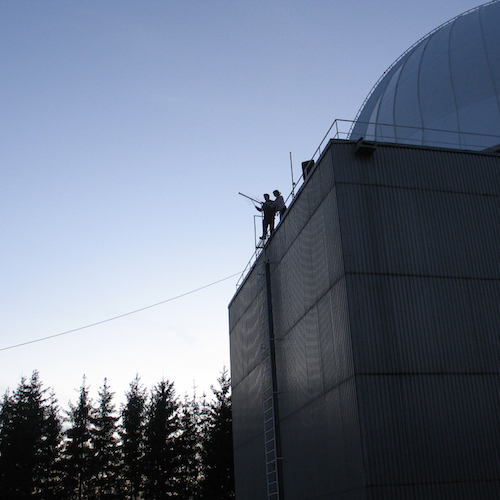[bandcamp width=400 height=400 album=3116232465 size=large bgcol=333333 linkcol=e99708 minimal=true]
::: murmer ::: songs for forgetting :::
LP+DL, gruenrekorder, 2016
I work very slowly, hence songs for forgetting has been in development for a very long time. The first element, a large sand timer, was recorded in Cologne, Germany in August, 2007. Further field recordings were made of rain dripping through Soviet-era gutter spouts in the small Estonian village of Tõravere (which happens to be home to northern Europe’s largest optical telescope) later that same month; daytime fireworks (mascleta, set off for sound rather than light) in Valencia, Spain (March, 2008); a pebble beach in Étretat, France (June, 2008); underwater life in a branch of the Andelle River in Perruel, France (May, 2009); and, more recently, the rain gutters at my current home in Põlgaste, Estonia (September, 2013) and the stridulation and footfalls of an inadvertently disturbed ant colony on Kemiö Island, Finland (July, 2014).
But the force that brought all these recordings together was an inadvertent tendency towards instrumental recordings, which feature in each of these ’songs‘. These instruments were all unfamiliar, and in some cases they were not ‚instruments‘ at all, in the literal sense of the word, but objects or spaces that nonetheless lent themselves to being played. I encountered them around the same time as the recordings mentioned above were being made, and recorded my explorations and improvisations, sometimes alone, sometimes with other players.
The first of these instruments was small and zither-like. It was, I learned only recently, a miniature Ukrainian bandura, and it was in an apartment in Berlin where I stayed during a visit in August, 2007. The apartment was the home of another sound artist whose name, Jeff Gburek, I’d known for years, but whom I had never (and still have not) met in person. He was out of town at the time; he didn’t know for years that I played and recorded his instrument (although, thanks to this release, he does now).
The next instrument was an old radio antenna, on the roof of the aforementioned observatory telescope in Tõravere, which sang a predetermined melody when you bowed it, which I did together with a native of that village, Piibe Kolka, in August, 2007 (Piibe’s bowing can be heard in the third song for forgetting). And in December of that year, in Vienna, Austria, I recorded an improvisation with the debris and trash under a small pedestrian bridge with Lasse-Marc Riek, who coincidentally co-curates the Gruenrekorder label, and visual artist Elffriede (this action can be heard in a fourth song for forgetting).
In February of the next year, while staying with Maksims Šentelevs in Riga, Latvia, I experimented with one of the many instruments in his collection, a small kora. And a year later in February, 2009 I recorded another tabletop zither, given to me by an old housemate from my time in London, the singer-songwriter Sam Semple, playing it with a small motor also given to me by Max from Riga.
With all the elements collected, the songs began to come together, very slowly, beginning in that summer of 2007, and finishing only now as this release is being prepared. They were built often in response to specific emotional situations, situations that demanded some forgetting themselves, so the title can be read two ways: what you forget is up to you.
A brief word about some elements of the design of the physical version of this release, which is the work of Vahram Muradyan, using elements from my own collection of found objects and detritus, which are printed and embossed on sleeves made for us by the Räpina Paper Factory, here in southeast Estonia, using 100% additive-free recycled fibre:
the front image is a reproduction of a leaf skeleton that I have had for some years – I can’t remember exactly where or when I found it, but I believe it is an aspen leaf from an Estonian forest. I have fond memories of recording aspen leaves in these forests, as they tremble in the wind. The maple and grape leaves that denote sides A and B of the vinyl were collected for their colors while traveling in France one autumn. The writing on the inner sleeve comes from one of several old school notebooks found in a mill ruin near my home, water-damaged and sun-faded, and mostly illegible. These notebooks make me think of memory and its loss, the fading away of the past. Included with the physical version is an original fragment of one of these notebooks.
Without the following people (along with those mentioned above) this release would not have been possible: Tuuli Tubin McGinley, Oliivia Tubin McGinley, Lasse-Marc Riek, Roland Etzin, Joshua Kunisch, Vahram Muradyan, Felicity Ford, Helmut Erler (who mastered the album at Dubplates & Mastering in Berlin), and Mihkel Peedimaa (from the Räpina Paper Factory, who made and donated the sleeves). Furthermore, this release has been produced with the help of a number of supporters, to whom I express my sincerest gratitude: Ariel Vitello, Bob Maier, Carole Kojo, Daniel McGinley, Eckhard Kuchenbecker, Greg Burrell, Hao-Tsun Kuo, Hitoshi Kojo, Irvic D’Olivier, James Bailey, Jonathan Coleclough, Julia Kümmel, Lauri Laanisto, Maren Möhring, Mark Stanley, Martin Clarke, Mike DePolo, Paul Fay, Udo Noll, and my colleagues at Resonance FM.
Patrick Tubin McGinley, April/October 2016
4 tracks (39’07”)
LP (300 copies) + digital
SONG FOR FORGETTING 12:48
ANOTHER SONG FOR FORGETTING 08:07
THE THIRD SONG FOR FORGETTING 11:25
A FOURTH SONG FOR FORGETTING 06:48
Sound Art Series by Gruenrekorder
Germany / 2016 / GRUEN 172 / LC 09488 / EAN 4050486966860






::: this would not have been possible without :::
Ailsa Watson, Andreas Oster, Andreas Usenbenz, Andres Kauts, Andrew, Andrew Campbell, Andrew Zarenski, Angus Carlyle, Anibal Pella-Woo, Ariel Vitello, Asha Scherbach, Barbara Ryan, Ben Link Collins, Benjamin Green, Benjamin Mouliets, Bernd Herzogenrath, Bob Maier, Bruce Davenport, Caleb Hughes, Carole Kojo, Carole Zarenski, Cathy Coley, Cecilia Hewett, Christina Kubisch, Christopher Delaurenti, Constantin Gröhn, Dallas Simpson, Daniel Crokaert, Daniel McGinley, Daniel Van Acker, Daron Gardner, Dave Seidel, David Brewington, DinahBird, Eamon Sprod, Eckhard Kuchenbecker, Edward Bordas, Eero Talvistu, Elo Vilks, Emilia Mello, Ernst Karel, Faizal Hirji, Felicity Ford, Flavien Gillié, Frank, Goh Lee Kwang, Greg Burrell, Hao-Tsun Kuo, Helen Frosi, Henrik Schröder, Hitoshi Kojo, Irvic D’Olivier, James Bailey, Jason Kanaris, Jeffrey Maslany, Jeph Jerman, Jeremy Young, Jerome Boillet, Joanna Ford, John W. Fail, Jonáš Gruska, Jonathan Coleclough, Jonathan Hart, Joseph Jaros, Joseph Young, Julia Kümmel, Kalle Kuisma, Kata Lubja, Ken Montgomery, Kostis Kilymis, Lauri Laanisto, Madli Kütt, Maksims Šentelevs, Marco (Pollo) Stabenow, Marcus Beuter, Maren Möhring, Marika Alver, Marja-Liisa Plats, Mark Stanley, Martin Clarke, Martin Kay, Matthew Swiezynski, Max Miller, Maxime Coton, Merily Värs, Mike DePolo, Mike Fazio, Mitchell Fukumoto, ◐ Mode Analogue, Nina Colombaro, Paul Fay, Peter Lenaerts, Phil Armstrong, Philipp Bückle, Rebecca Moffett, Resonance FM, Richard Bentley, Richie Warburton, Rigulf Hefendehl, Ruben Guzman, Sam Semple, Scott Sherk, Sean Kelly, Sebastiane Hegarty, Simon, Slavek Kwi, Stéphane Marin, Steve Roden, Taavi Suisalu, Timo Toots, Tobias Arnold, Tom Zarenski, Udo Noll, Urtzi, Yannick Allard
::: our sincerest thanks! :::
::: reviews :::
Murmer is the project of Patrick McGinley, a sound artist working in Estonia. On this 2016 release from Gruenrekorder, McGinley constructs four compositions using fragments of found sounds, including field recordings collected over nearly a decade, and improvisational music played with unusual instruments (mainly of the stringed variety: a Ukrainian bandura, a kora, various zithers) or objects that McGinley discovered on his travels, such as an old radio antenna played with a bow. “Song for Forgetting” (T1) is a quiet piece centered around the crystalline plucking of strings. “Another Song for Forgetting” (T2) weaves soft drones, vibrations like a teacup rattling in its saucer, and field recordings of falling water. “The Third Song for Forgetting” (T3) brings sounds of crashing waves, deeper tones from strings, round reverberations. “A Fourth Song for Forgetting” (my favorite) begins with the wandering plucking of strings and sounds of objects being placed, dropped, thrown, shattered; slowly, it all builds into a weird, wild confusion, with a fireworks display as the grand finale. Like the music, the album’s artwork is also crafted from materials at hand – the cover image is a leaf McGinley found in the woods, and enclosed in the sleeve are faded pages from notebooks from a abandoned mill near his home. Together, this thoughtful work reminds us of the surprising beauty that can be found in everyday experiences that would usually be forgotten.
::: lexi glass ::: kfjc, february 2017 :::
The American ex-pat Patrick McGinley (aka Murmer) has now taken up residence in a rural village in Estonia after many years of wanderings and explorations. To this day, he continues to roam any and all environments, collecting field recordings and his own interventions with a particular place. It has been almost five years since his last solo work, but McGinley remains a steadfast champion the field recording within composition through his weekly Framework radio series, broadcast on Resonance FM and beyond through numerous radio and online outlets. Songs For Forgetting highlights McGinley’s talents in molding and shaping tone and subtle melody from deep within the fundamental sounds of a particular environmental sound. At the same time, he’ll interject actual instrumentation. The playful clatter of McGinley tinkering with a zither ringing in the vein of Harry Partch set in motion against a humid chorus of cicadas and spellbinding dronescaping. Witness the psalter-like halo blossoms on the second half of the record, where we find McGinley bowing a Soviet era antenna mounted at the top of an near-space observational telescope. The resulting harmonics and pastorally minimalist drones are drop-dead gorgeous, as richly sonorous as anything Pauline Oliveros and Charlemagne Palestine would compose through more conventional means. Songs For Forgetting manifests into a beautiful record, packaged in an suitably rough-hewn, embossed sleeve that was fabricated at the Rapina Paper Factory in southeast Estonia. McGinley has included considerable notes and ephemera, turning this into an wondrous objet d’art.
::: stranded records, february 2017 :::
North American sound, performer and radio artist Patrick McGinley (AKA murmer) in based in Europe since 1996 and since then he has been working with found sounds and found objects. He hold a string of releases and compilation appearances. Murmer’s work consists of micro sounds and field records and on this album McGinley collects sounds in different parts of Europe between 2007 and 2014, like a sand timer recorded in Cologne, Germany in August 2007. Other field recordings were made with rain dripping through cannons of the Soviet era in the small village of Tóravere in Estonia. Then in the same month; daytime fireworks in Valencia, Spain (March 2008); a pebble beach in Étretat, France (June 2008); underwater life on a branch of the Andelle river in Perruel, France (May 2009); and more recently, the rain gutters in my current house in Põlgaste, Estonia (September 2013) and the squeaking and trampling of an ant colony in the island of Kemiö, Finland (July 2014). The last track of this album „The Third Song for Forgetting“ shows the soft sound of the sea water that reaches the shore and is collected and in the background, a hypnotic and penetrating drone.
::: guillermo escudero ::: loop, january 2017 :::
Patrick Tubin McGinley works, as Murmer, since many years is not someone who releases a lot of music. In fifteen years, ‚Songs For Forgetting‘ is his eleventh album and deals, as much of his other work, with field recordings, but on this album McGinley explores also musical instruments. Zither like such as in the title piece but he doesn’t always conventional instruments, such as an old radio antenna. The goal of each of the four pieces is to mix up field recordings (although these can also be spaces in which the music is performed) and these instruments and come up with a more musical context than what is usually the case with this kind of music. Four lengthy pieces, of which the title piece is a fine string piece, mildly plucked and ‚Another Song For Forgetting‘ works with overtones and the rattling of objects; maybe the overtones are created with the use of feedback, but it nicely wanders around. In ‚The Third Song Of Forgetting‘ we hear, and perhaps for the first time (and we are already on the second side), clearly the sound of sea waves, which seems to be a first in the field recordings department. In the previous two pieces there might have been some field recordings, but not a lot, or perhaps treated in some way that we no longer recognize them. Once these waves have washed away, there is some beautiful overtone music left. I suspect these to come from using a bow on a zither, maybe with a little bit of amplification. The fourth piece, another variation on the title of the album, is the most chaotic piece. Here we have the sound of fireworks, and a bunch of people (includes label boss Lasse-Marc Riek) plucking a bunch of stringed instruments; I would think this recording is made outside, during those fireworks, and maybe the playing reflects the chaos of fireworks, and perhaps such a piece makes sense after three rather delicate pieces of careful bending sounds and colouring tones, to get something entirely different but it also breaks down the carefully constructed mood and as such it didn’t work out for me too well. I rather would have another one of those more careful build sonic constructions, but with 3/4 of the record being absolutely great, who am I to complain?
::: frans de waard ::: vital weekly #1066, january 2017 :::
Quite surreal murmer explores the ignored small sounds that occupy life on “song for forgetting”. Merging elements of ambient and field recordings these are pieces that at times recall the raw industrial edge of early Zoviet*France albums. Within these pieces murmer forgoes melody and rhythm for something much looser. Almost improvisational in their approach the way that the songs evolve has a life-like cryptic element to it. By taking on this tact murmer creates layer upon layer of sound that interact in a plethora of unexpected strange ways.Things open up with the tiny sounds of “Another Song For Forgetting”. Setting the tone for what follows the sounds seem to be living, breathing creatures, small bursts of their breath emerges out of the sonic ether. From there a drone forms one that extends into the infinite. A nautical atmosphere defines the nimble work of “A Fourth Song For Forgetting” where the many sounds appear to bounce off of each other, as a kind of scraped guitar sound begins to make its presence felt. Some really far gone sounding blues comes out of this experimentation before it descends into outright noise. Nearly tender is the gentle “Song For Forgetting” whose off-kilter balance gives it a delicacy of sorts, as the fragile structure barely stays afloat. Tying everything together is the blissful album closer, the pristine serenity of “The Third Song For Forgetting”. With “songs for forgetting” murmer amplifies the minuscule micro sounds that are all around.
::: beach sloth, december 2016 :::